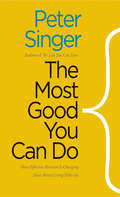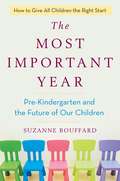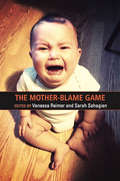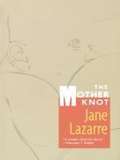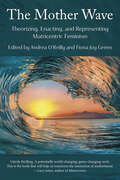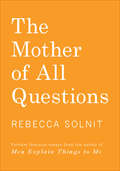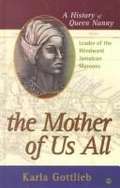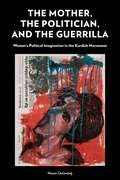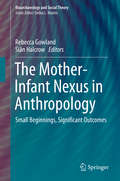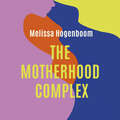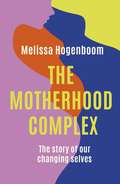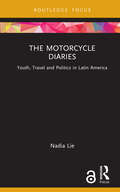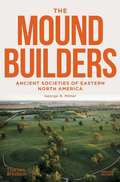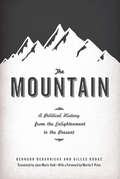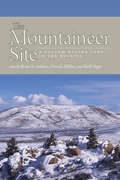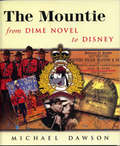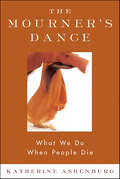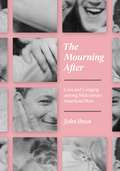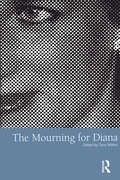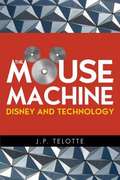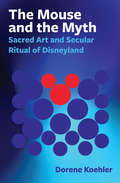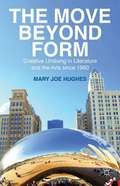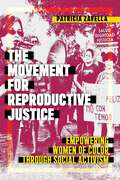- Table View
- List View
The Most Good You Can Do: How Effective Altruism Is Changing Ideas About Living Ethically (Castle Lectures Ser.)
by Peter SingerAn argument for putting sentiment aside and maximizing the practical impact of our donated dollars: &“Powerful, provocative&” (Nicholas Kristof, The New York Times). Peter Singer&’s books and ideas have been disturbing our complacency ever since the appearance of Animal Liberation. Now he directs our attention to a challenging new movement in which his own ideas have played a crucial role: effective altruism. Effective altruism is built upon the simple but profoundly unsettling idea that living a fully ethical life involves doing the &“most good you can do.&” Such a life requires a rigorously unsentimental view of charitable giving: to be a worthy recipient of our support, an organization must be able to demonstrate that it will do more good with our money or our time than other options open to us. Singer introduces us to an array of remarkable people who are restructuring their lives in accordance with these ideas, and shows how, paradoxically, living altruistically often leads to greater personal fulfillment than living for oneself. Doing the Most Good develops the challenges Singer has made, in the New York Times and Washington Post, to those who donate to the arts, and to charities focused on helping our fellow citizens, rather than those for whom we can do the most good. Effective altruists are extending our knowledge of the possibilities of living less selfishly, and of allowing reason, rather than emotion, to determine how we live. Doing the Most Good offers new hope for our ability to tackle the world&’s most pressing problems.
The Most Important Year: Pre-Kindergarten and the Future of Our Children
by Suzanne BouffardAn eye-opening look inside pre-K in America and what it will take to give all children the best start in school possible. At the heart of this groundbreaking book are two urgent questions: What do our young children need in the earliest years of school, and how do we ensure that they all get it? Cutting-edge research has proven that early childhood education is crucial for all children to gain the academic and emotional skills they need to succeed later in life. Children who attend quality pre-K programs have a host of positive outcomes including better language, literacy, problem-solving and math skills down the line, and they have a leg up on what appears to be the most essential skill to develop at age four: strong self-control. But even with this overwhelming evidence, early childhood education is at a crossroads in America. We know that children can and do benefit, but we also know that too many of our littlest learners don’t get that chance—millions of parents can’t find spots for their children, or their preschoolers end up in poor quality programs. With engrossing storytelling, journalist Suzanne Bouffard takes us inside some of the country’s best pre-K classrooms to reveal the sometimes surprising ingredients that make them work—and to understand why some programs are doing the opposite of what is best for children. It also chronicles the stories of families and teachers from many backgrounds as they struggle to give their children a good start in school. This book is a call to arms when we are at a crucial moment, and perhaps on the verge of a missed opportunity: We now have the means and the will to have universal pre-kindergarten, but we are also in grave danger of not getting it right.
The Mother Blame Game
by Vanessa ReimerThe Mother-Blame Game is an interdisciplinary and intersectional examination of the phenomenon of mother-blame in the twenty-first century. As the socioeconomic and cultural expectations of what constitutes “good motherhood” grow continually narrow and exclusionary, mothers are demonized and stigmatized—perhaps now more than ever—for all that is perceived to go “wrong” in their children’s lives. This anthology brings together creative and scholarly contributions from feminist academics and activists alike to provide a dynamic study of the many varied ways in which mothers are blamed and shamed for their maternal practice. Importantly, it also considers how mothers resist these ideologies by engaging in empowered and feminist mothering practices, as well as by publicly challenging patriarchal discourses of “good motherhood.”
The Mother Knot
by Jane LazarreIn this compelling memoir by a writer, mother, and feminist, Jane Lazarre confronts the myth of the "good mother" with her fiercely honest and intimate portrait of early motherhood as a time of profound ambivalence and upheaval, filled with desperation as well as joy, the struggle to reclaim a sense of self, and sheer physical exhaustion. Originally published in 1976, The Mother Knot is a feminist classic, as relevant today as it was twenty years ago.
The Mother Wave: Theorizing, Enacting, and Representing Matricentric Feminism
by Andrea O’Reilly;Fiona Joy GreenMatricentric feminism seeks to make motherhood the business of feminism by positioning mothers' needs and concerns as the starting point for a theory and politic on and for the empowerment of women as mothers. Based on the conviction that mothering is a verb, it understands that becoming and being a mother is not limited to biological mothers or cisgender women but rather to anyone who does the work of mothering as a central part of their life. The Mother Wave, the first-ever book on the topic, compellingly explores how mothers need a matricentric mode of feminism organized from and for their particular identity and work as mothers, and because mothers remain disempowered despite sixty years of feminism. The anthology makes visible the power of matricentric feminism as it is theorized, enacted, and represented to realize and achieve the subversive potential of mothers and their contributions to feminist theory and activism. Contributors share the impact and influence of matricentric feminism on families and children, culture, art/literature, education, public policy, social media, and workplace practices through personal reflections, scholarly essays, memoir, creative non-fiction, poetry, and photography. The mother wave of matricentric feminism invites conversations with others and offers a praxis of feminism that aims to coexist, overlap, and intersect with others.
The Mother of All Questions
by Rebecca SolnitIn a timely and incisive follow-up to her national bestseller Men Explain Things to Me, Rebecca Solnit offers sharp commentary on women who refuse to be silenced, misogynistic violence, the fragile masculinity of the literary canon, the gender binary, the recent history of rape jokes, and much more. In characteristic style, Solnit mixes humor, keen analysis, and sharp insight in these eleven essays.
The Mother of Us All: A History of Queen Nanny, Leader of the Windward Jamaican Maroons
by Karla Lewis GottliebThe author analyzes the importance of Queen Nanny from cultural, military, historical, and religious point of view. This book marks an attempt to integrate a key figure of New World history into her rightful place as the leader of a critical resistance movement in Jamaica in the first part of the 18th century.
The Mother, the Politician, and the Guerrilla: Women’s Political Imagination in the Kurdish Movement
by Nazan ÜstündağThe Mother, the Politician, and the Guerrilla intervenes in discussions on decolonialism and feminism by introducing the example of the Kurdish Women’s Freedom Movement. Üstündağ shows how the practices and the concepts of the movement contribute to debates on how the past, present, and future can be critically rethought in revolutionary ways.In the movement’s images, figures, voices, bodies, and their reverberations Üstündağ elaborates a new political imagination that has emerged in Kurdistan through women’s acts and speech. This political imagination unfolds between flesh, body, voice, language. It is the result of Kurdish women’s desire to find new ways of being and becoming, between the necessary and the possible.Focusing on the figures of the mother, the woman politician and woman guerilla, Üstündağ argues that the Kurdish Women’s Freedom Movement changes what politics consists of, including its matter, relationality, temporality, and spatiality. Although anchored in the specific Kurdish experiences, the book puts the movement into conversation with feminist political theory, psychoanalysis, Black Studies, Queer Studies, and Decolonial Studies. In solidarity with the Kurdish Movement’s tradition of resistance to History with a capital H that Kurds have built through reiterated performance, the book seeks to establish what new entanglements with wide-ranging thought the movement offers as a provocation for contemporary politics.
The Mother-Infant Nexus in Anthropology: Small Beginnings, Significant Outcomes (Bioarchaeology and Social Theory)
by Rebecca Gowland Siân HalcrowOver the past 20 years there has been increased research traction in the anthropology of childhood. However, infancy, the pregnant body and motherhood continue to be marginalised. This book will focus on the mother-infant relationship and the variable constructions of this dyad across cultures, including conceptualisations of the pregnant body, the beginnings of life, and implications for health. This is particularly topical because there is a burgeoning awareness within anthropology regarding the centrality of mother-infant interactions for understanding the evolution of our species, infant and maternal health and care strategies, epigenetic change, and biological and social development. This book will bring together cultural and biological anthropologists and archaeologists to examine the infant-maternal interface in past societies. It will showcase innovative theoretical and methodological approaches towards understanding societal constructions of foetal, infant and maternal bodies. It will emphasise their interconnectivity and will explore the broader significance of the mother/infant nexus for overall population well-being.
The Motherhood Complex: The Story of Our Changing Selves (Karen Pirie #44)
by Melissa Hogenboom'THE MOTHERHOOD COMPLEX does for mothers in particular what INVISIBLE WOMEN did for women as a whole: exposes the myriad ways in which the system is stacked against us, while celebrating the strengths and successes we achieve in spite of it all' Leah Hazard'A welcome, refreshing and clear-eyed look at the twenty-first century expectations of motherhood' Gina RipponEnriched with discoveries from biology, psychology and social science, THE MOTHERHOOD COMPLEX is a journey to the heart of what it means to become a mother.Melissa Hogenboom examines how the suite of changes we experience during pregnancy and motherhood influence our sense of self, both physically and from the wider world. From the way our brain changes during pregnancy and the psychological impact of our changing body, to the true cost of the motherhood workplace penalty and the intrusion of technology on family life, Hogenboom reveals how external events and society at large shape the way we see ourselves and impacts upon the choices we make.Interweaving her personal experience as a mother of two young children with the latest research, Hogenboom confronts the modern myth of maternal perfection and highlights the importance of understanding how and why we change for our physical and emotional health.
The Motherhood Complex: The story of our changing selves
by Melissa Hogenboom'THE MOTHERHOOD COMPLEX does for mothers in particular what INVISIBLE WOMEN did for women as a whole: exposes the myriad ways in which the system is stacked against us, while celebrating the strengths and successes we achieve in spite of it all' Leah Hazard'A welcome, refreshing and clear-eyed look at the twenty-first century expectations of motherhood' Gina RipponEnriched with discoveries from biology, psychology and social science, THE MOTHERHOOD COMPLEX is a journey to the heart of what it means to become a mother.Melissa Hogenboom examines how the suite of changes we experience during pregnancy and motherhood influence our sense of self, both physically and from the wider world. From the way our brain changes during pregnancy and the psychological impact of our changing body, to the true cost of the motherhood workplace penalty and the intrusion of technology on family life, Hogenboom reveals how external events and society at large shape the way we see ourselves and impacts upon the choices we make.Interweaving her personal experience as a mother of two young children with the latest research, Hogenboom confronts the modern myth of maternal perfection and highlights the importance of understanding how and why we change for our physical and emotional health.
The Motherless Child in the Novels of Pauline Hopkins
by Jill BergmanWell known in her day as a singer, playwright, author, and editor of the Colored American Magazine, Pauline Hopkins (1859--1930) has been the subject of considerable scholarly attention over the last twenty years. Academic review of her many accomplishments, however, largely overlooks Hopkins's contributions as novelist. The Motherless Child in the Novels of Pauline Hopkins, the first book-length study of Hopkins's major fiction, fills this gap, offering a sustained analysis of motherlessness in Contending Forces, Hagar's Daughter, Winona, and Of One Blood. Motherlessness appears in all of Hopkins's novels. The motif, Jill Bergman asserts, resonated profoundly for African Americans living with the legacy of abduction from a motherland and familial fragmentation under slavery. In her novels, motherlessness serves as a trope for the national alienation of post-Reconstruction African Americans. The longing and search for a maternal figure, then, represents an effort to reconnect with the absent mother -- a missing parent and a lost African history and heritage. In Hopkins's oeuvre, the image of the mother of African heritage -- a source of both identity and persecution -- becomes a source of power and possibility. Bergman shows how historical events -- such as Bleeding Kansas, the execution of John Brown, and the Middle Passage -- gave rise to a sense of motherlessness and how Hopkins's work engages with that of other contemporaneous race activists. This illuminating study opens new terrain not only in Hopkins scholarship, but also in the complex interchanges between literary, African American, psychoanalytic, feminist, and postcolonial studies.
The Motorcycle Diaries: Youth, Travel and Politics in Latin America (Cinema and Youth Cultures)
by Nadia LieThe first monograph to examine Walter Salles’ The Motorcycle Diaries, this book explains the significance of Salles’ film with respect to the specific category of ‘youth culture’ as a historically and culturally situated concept. The Motorcycle Diaries looks at the film’s engagement with ‘emerging adulthood’, the importance of travel as a source of self-discovery, and the film’s impact on the iconicity of Che Guevara, the international emblem of a restless, rebellious youth. Combining insights from transnational film studies, tourism studies and affect theory, as well as drawing on extensive historical materials, this book provides not only a necessary addition to existing scholarship on this popular movie, but also an inspiring model for the analysis of film in relation to youth culture - a burgeoning field of interest in Latin American scholarship. It will interest any scholar in film studies, specifically transnational cinemas, global cinema, Latin American cinema, Latin American history, postcolonial studies, cultural studies, tourism studies and global politics.
The Mottled Lizard
by Elspeth HuxleyA story of a young lady returning to her beloved Africa after World War II. She has to deal with what is left after the war, with her houseboy, local help, other European friends. She learns that there are diseases and emergencies that can't be dealt with, this far from Nairobi.
The Moundbuilders: Second Edition
by George R. MilnerBrought up to date with the latest research, The Moundbuilders is the definitive visual guide to North America’s eastern region and the societies that forever changed its landscape. Hailed by Bruce D. Smith, curator of North American archaeology at the Smithsonian Institution, as “without question the best available book on the pre-Columbian . . . societies of eastern North America,” this wide-ranging and richly illustrated volume covers the entire prehistory of the Eastern Woodlands and the thousands of earthen mounds that can be found there, built between 3100 BCE and 1600 CE. The second edition of The Moundbuilders has been brought fully up-to-date, with the latest research on the peopling of the Americas, including more coverage of pre-Clovis groups, new material on Native American communities in the thirteenth to sixteenth centuries CE, and new narratives of migration drawn from ancient and modern DNA. Far-reaching and illustrated throughout, this book is the perfect visual guide to the region for students, tourists, archaeologists, and anyone interested in ancient American history.
The Mountain: A Political History from the Enlightenment to the Present
by Bernard Debarbieux Gilles RudazIn The Mountain, geographers Bernard Debarbieux and Gilles Rudaz trace the origins of the very concept of a mountain, showing how it is not a mere geographic feature but ultimately an idea, one that has evolved over time, influenced by changes in political climates and cultural attitudes. To truly understand mountains, they argue, we must view them not only as material realities but as social constructs, ones that can mean radically different things to different people in different settings. From the Enlightenment to the present day, and using a variety of case studies from all the continents, the authors show us how our ideas of and about mountains have changed with the times and how a wide range of policies, from border delineation to forestry as well as nature protection and social programs, have been shaped according to them. A rich hybrid analysis of geography, history, culture, and politics, the book promises to forever change the way we look at mountains.
The Mountaineer Site: A Folsom Winter Camp in the Rockies
by David J. Meltzer Mark Stiger Brian N. AndrewsThe Mountaineer Site presents over a decade’s worth of archaeological research conducted at Mountaineer, a Paleoindian campsite in Colorado’s Upper Gunnison Basin. Mountaineer is one of the very few extensively excavated, long-term Folsom occupations with evidence of built structures. The site provides a rich record of stone tool manufacture and use, as well as architectural features, and offers insight into Folsom period adaptive strategies from a time when the region was still in the grip of a waning Ice Age. Contributors examine data concerning the structures, the duration and repetition of occupations, and the nature of the site’s artifact assemblages to offer a valuable new perspective on human activity in the Rocky Mountains in the Late Pleistocene. Chapters survey the history of fieldwork at the site and compare and explain the various excavation procedures used; discuss the geology, taphonomic history, and geochronology of the site; analyze artifacts and other recovered materials; examine architectural elements; and compare the present and past environments of the Upper Gunnison Basin to gain insight into the setting in which Folsom groups were operating and the resources that were available to them. The Folsom archaeological record indicates far greater variability in adaptive behavior than previously recognized in traditional models. The Mountaineer Site shows how accounting for reduced mobility, more generalized subsistence patterns, and variability in tool manufacture and use allows for a richer and more accurate understanding of Folsom lifeways. It will be of great interest to graduate students and archaeologists focusing on Paleoindian archaeology, hunter-gatherer mobility, lithic technological organization, and prehistoric households, as well as prehistorians, anthropologists, and social scientists. Contributors: Richard J. Anderson, Andrew R. Boehm, Christy E. Briles, Katherine A. Cross, Steven D. Emslie, Metin I. Eren, Richard Gunst, Kalanka Jayalath, Brooke M. Morgan, Cathy Whitlock
The Mountie from Dime Novel to Disney
by Michael DawsonHistorian Michael Dawson digs deep into the written and pictorial record to reveal how the RCMP, since its inception, has constructed and zealously guarded its public image. Drawing on previously untapped sources, Dawson documents how consultants and entrepreneurs deliberately transformed and modernized the traditional symbolism of the Mountie. His trenchant analysis extends to the ironies of the recent licensing of the hallowed Mountie image to the ultimate dream-merchants-Disney.
The Mourner's Dance: What We Do When People Die
by Katherine AshenburgWhen her daughter's fiancé died suddenly, Katherine Ashenburg was surprised to see how her daughter intuitively re-created the traditional rituals of mourning, even those of which she was ignorant. Intrigued, Ashenburg began to explore the rich and endlessly inventive choreographies different cultures and times have devised to mark a universal and deeply felt plight.Contemporary North American culture favors a mourning that is private and virtually invisible. But, as Ashenburg reveals, the grieving customs of the past were so integrated into daily life that ultimately they gave rise to public parks and ready-to-wear clothing. Our keepsakes, prescribed bereavement garb, resting places, mourning etiquette; and ways of commiserating from wakes to Internet support groups remain clues to our most elemental beliefs, and our most effective means of restoring selves, and communities, unraveled by loss.
The Mourning After: Loss and Longing among Midcentury American Men
by John IbsonOn the battlefields of World War II, with their fellow soldiers as the only shield between life and death, a generation of American men found themselves connecting with each other in new and profound ways. Back home after the war, however, these intimacies faced both scorn and vicious homophobia. The Mourning After makes sense of this cruel irony, telling the story of the unmeasured toll exacted upon generations of male friendships. John Ibson draws evidence from the contrasting views of male closeness depicted in WWII-era fiction by Gore Vidal and John Horne Burns, as well as from such wide-ranging sources as psychiatry texts, child development books, the memoirs of veterans’ children, and a slew of vernacular snapshots of happy male couples. In this sweeping reinterpretation of the postwar years, Ibson argues that a prolonged mourning for tenderness lost lay at the core of midcentury American masculinity, leaving far too many men with an unspoken ache that continued long after the fighting stopped, forever damaging their relationships with their wives, their children, and each other.
The Mourning for Diana
by Tony WalterThe unexpected death of Diana, Princess of Wales, in Paris on August 31st 1997 led to a period of mourning over the next week that took the world by surprise. Major institutions - the media, the royal family, the church, the police - for once had no pre-planned script. For the public, this was a story with an ending they had not anticipated. How did these institutions and the public create a cultural order in the face of such disorder? Both those involved in the mourning and those who objected to it struggled to understand the depth and breadth of emotion shaking Britain and the world. Mourning was focused on London, where Diana's body lay, and on Diana's home, Kensington Palace. Throughout the city and especially in Kensington Gardens, millions left shrines to the dead princess made of flowers, messages, teddy bears and other objects. In towns and villages around the UK, this was repeated. The mourning was also global, with media dominated by Diana's death in scores of countries. The funeral itself had a record-breaking world television audience, and messages of condolence floated around the globe in cyber-space. How unique was all this? Does it mark a shift in the culture of mourning, of the position of the monarchy, of the role of emotion in British culture? How does it compare with the mourning for other super-icons - JFK, Evita, Elvis, and Monroe? Was it media-induced hysteria? Or was it simply a magnification of normal mourning behaviour? Focusing on the extraordinary actions of millions of ordinary people, this book documents what happened and shows how a modern rational society coped with the unexpected in a proto-revolutionary week that left participants and objectors alike asking 'why did we behave like this?'
The Mouse Machine: Disney and Technology
by J P. TelotteThroughout Disney's phenomenally successful run in the entertainment industry, the company has negotiated the use of cutting-edge film and media technologies that, J. P. Telotte argues, have proven fundamental to the company's identity. Disney's technological developments include the use of stereophonic surround sound for Fantasia, experimentation with wide-screen technology, inaugural adoption of three-strip Technicolor film, and early efforts at fostering depth in the animated image. Telotte also chronicles Disney's partnership with television, development of the theme park, and depiction of technology in science fiction narratives. An in-depth discussion of Disney's shift into digital filmmaking with its Pixar partnership and an emphasis on digital special effects in live-action films, such as the Pirates of the Caribbean series, also highlight the studio's historical investment in technology. By exploring the technological context for Disney creations throughout its history, The Mouse Machine illuminates Disney's extraordinary growth into one of the largest and most influential media and entertainment companies in the world. Hardback is unjacketed.
The Mouse and the Myth: Sacred Art and Secular Ritual of Disneyland (Encounters: Explorations in Folklore and Ethnomusicology)
by Dorene KoehlerUpholds &“a Disney vacation as a religious experience . . . [offers] insightful arguments relating to the nature of play as well as Nietzschean philosophy&” (Reading Religion). Rituals mark significant moments in our lives—perhaps none more significant than moments of lightheartedness, joy, and play. Rituals of play are among the most sacred of any of the rites in which humanity may engage. Although we may fail to recognize them, they are always present in culture, providing a kind of psychological release for their participants, child and adult alike. Disneyland is an example of the kind of container necessary for the construction of rituals of play. This work explores the original Disney theme park in Anaheim as a temple cult. It challenges the disciplines of mythological studies, religious studies, film studies, and depth psychology to broaden traditional definitions of the kind of cultural apparatus that constitute temple culture and ritual. It does so by suggesting that Hollywood&’s entertainment industry has developed a platform for mythic ritual. After setting the ritualized &“stage,&” this book turns to the practices in Disneyland proper, analyzing the patron&’s traditions within the framework of the park and beyond. It explores Disneyland&’s spectacles, through selected shows and parades, and concludes with an exploration of the park&’s participation in ritual renewal. &“There is much to commend in Koehler&’s study . . . Surely, her work should encourage others to examine myth construction and sacred-secular rituals in popular culture.&”—H-Celebration
The Move beyond Form
by Mary Joe HughesFictional narratives of the late twentieth century often cross boundaries. This study argues that the undoing of structure in postmodern art form demands a different way of thinking and represents a commentary on the material and social conditions of the late twentieth century and beyond.
The Movement for Reproductive Justice: Empowering Women of Color through Social Activism (Social Transformations in American Anthropology #5)
by Patricia Zavella2021 Outstanding Academic Title, Choice MagazineShows how reproductive justice organizations' collaborative work across racial lines provides a compelling model for other groups to successfully influence changePatricia Zavella experienced firsthand the trials and judgments imposed on a working professional mother of color: her own commitment to academia was questioned during her pregnancy, as she was shamed for having children "too young." And when she finally achieved her professorship, she felt out of place as one of the few female faculty members with children. These experiences sparked Zavella’s interest in the movement for reproductive justice. In this book, she draws on five years of ethnographic research to explore collaborations among women of color engaged in reproductive justice activism. While there are numerous organizations focused on reproductive justice, most are racially specific, such as the National Asian Pacific American Women's Forum and Black Women for Wellness. Yet Zavella reveals that many of these organizations have built coalitions among themselves, sharing resources and supporting each other through different campaigns and struggles. While the coalitions are often regional—or even national—the organizations themselves remain racially or ethnically specific, presenting unique challenges and opportunities for the women involved. Zavella argues that these organizations provide a compelling model for negotiating across differences within constituencies. In the context of the war on women's reproductive rights and its disproportionate effect on women of color, and increased legal violence toward immigrants, The Movement for Reproductive Justice demonstrates that a truly intersectional movement built on grassroots organizing, culture shift work, and policy advocating can offer visions of strength, resiliency, and dignity for all.
